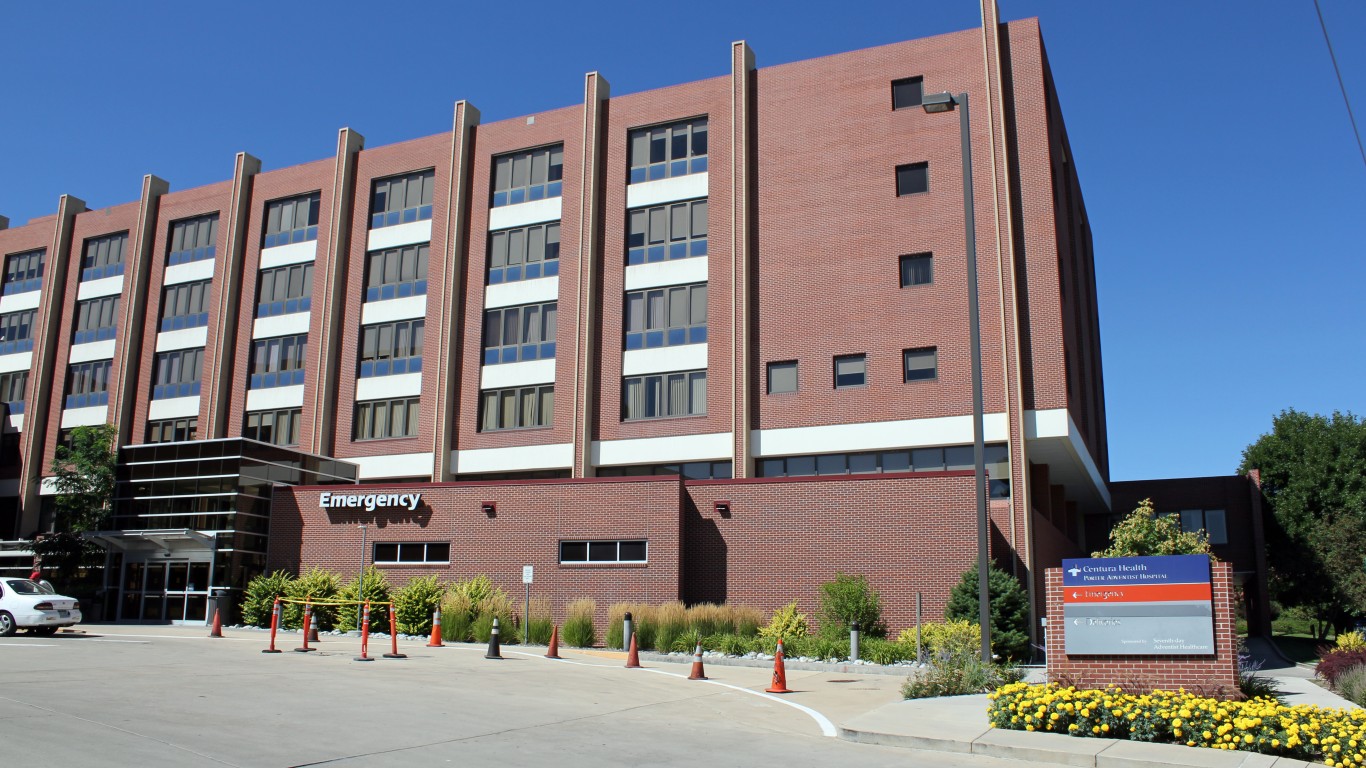
This post may contain links from our sponsors and affiliates, and Flywheel Publishing may receive
compensation for actions taken through them.
The United States is one of the richest and most developed countries in the world, and its spending on health care is by far the largest in the world. But, as it turns out, money doesn’t always buy health. While there has been a significant decline in the mortality rate over the last few decades, and the smoking rate is at its lowest ever, the U.S. still struggles with high incidence of chronic health conditions.
24/7 Tempo examined the 20 healthiest states in America from the United Health Foundation’s 2019 Health Rankings report. It includes such factors as healthy behaviors, quality of health care, health policy, the presence of diseases, and deaths from illnesses across the nation.
Click here for the 20 healthiest states in America.
Click here for our methodology.
Health varies considerably between states. The prevalence of diabetes has increased dramatically in the United States in recent years, going from 9.5% in 2012 to 10.9% in 2018. However, in the 20 healthiest states in the country, the rates of diabetes are less than the national rate of nearly 11% of adults. Also since 2012, obesity levels have increased from 27.8% to 30.9% of adults. Only four of the 20 healthiest states in America have a higher adult obesity rate than the national.
Healthy behaviors and lifestyles are also major contributors to good health. Just over 75% of Americans report regular physical activity. In only two of the 20 healthiest states, fewer people exercise regularly. But working out is just one way people can stay healthy. Nutrition plays a major, if not a more important, role — and here are 29 healthy habits that will change your life.
The cost of poor health can be measured in years of life. The Centers for Disease Control and Prevention (CDC) track premature deaths, as measured by the number of years lost when people do not live to age 75. In 2019, the CDC estimated that nearly 7,500 years were lost for every 100,000 Americans. This figure was lower in all of the 20 healthiest states.
Money is also a factor in determining health. The healthiest states are often among the nation’s wealthiest, and only two of the 20 healthiest states have a median household income under the national median in 2018. Not everybody has a job that pays six figures, but there are ways to make some extra money — these are 18 hobbies you can actually make money on.

20. Iowa
> Premature death rate (per 100,000): 6,733 (16th lowest)
> Adult obesity rate: 35.3% (7th highest)
> Adult smoking rate: 16.6% (23rd highest)
> Median household income: $59,955 (25th highest)
Iowa makes the list of healthiest states in the country based on a wide range of factors. Only 9.6% of the population reported 14 or more days of poor physical health in a month — the second smallest share of all states — compared to a national average of 12.0%.
The low uninsured rate in the state — just 4.7% of Iowans do not have health insurance, the sixth smallest share in the country — may also be a major factor. People without health insurance are more likely than those with insurance to delay going to the doctor or forgo taking care of their health altogether.
See all stories featuring: Iowa
[in-text-ad]

19. Wyoming
> Premature death rate (per 100,000): 7,412 (23rd lowest)
> Adult obesity rate: 29.0% (14th lowest)
> Adult smoking rate: 18.8% (16th highest)
> Median household income: $61,584 (20th highest)
Wyoming has one of the lowest rates of cancer-related deaths, the second leading cause of death in the United States after heart disease. There are 169.5 cancer deaths per 100,000 people in Wyoming, the sixth lowest rate in the country and way below the U.S. average of 189.3 per 100,000 people.
Diabetes, a disease that affects about a tenth of the U.S. population, is also relatively uncommon in Wyoming. An estimated 8.7% of adults in Wyoming have been diagnosed, the fifth lowest percentage in the country.
See all stories featuring: Wyoming
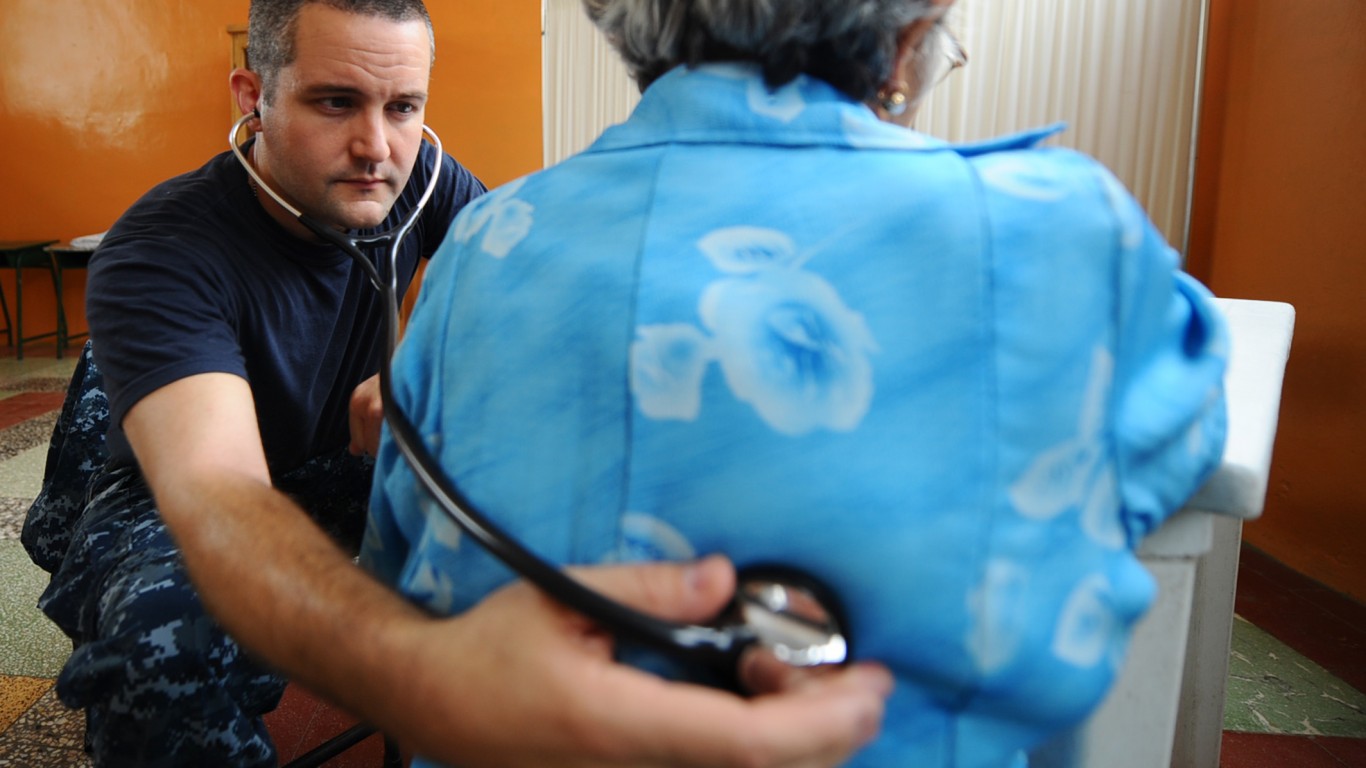
18. Maryland
> Premature death rate (per 100,000): 7,689 (23rd highest)
> Adult obesity rate: 30.9% (25th highest)
> Adult smoking rate: 12.5% (5th lowest)
> Median household income: $83,242 (the highest)
One factor contributing to Maryland’s better-than-average health outcomes and behaviors may be income. The higher the income, the lower the likelihood of disease and premature death, as wealthier people can afford healthier diets and have more access to high-quality health care. Maryland has the highest median household income and the fourth lowest poverty rate in the country.
It also has a relatively small share of adults who drink excessively — 14.6%, compared to a U.S. average of 18.2%. Over time, excessive drinking can lead to serious problems, such as hypertension, heart disease, stroke, liver disease, and digestive problems.
See all stories featuring: Maryland

17. Nebraska
> Premature death rate (per 100,000): 6,555 (11th lowest)
> Adult obesity rate: 34.1% (15th highest)
> Adult smoking rate: 16.0% (24th lowest)
> Median household income: $59,566 (25th lowest)
Compared to the rest of the country, relatively few people in Nebraska report frequent mental or physical distress. Only 11.2% of the state’s adult population reported 14 or more days of poor mental health in one month, the 10th smallest share in the country. There is a strong correlation between frequent mental distress and diagnosed mental disorders, such as depression and anxiety, according to the United Health Foundation. About 10.2% reported 14 or more days of poor physical health in one month, the sixth smallest share in the United States.
Nebraskans also have relatively healthy behaviors. For example, from 2015 to 2017 there were just 7.2 drug-related deaths per 100,000 residents a year, less than half the national rate and the lowest rate in the country.
See all stories featuring: Nebraska
[in-text-ad-2]

16. Idaho
> Premature death rate (per 100,000): 6,669 (15th lowest)
> Adult obesity rate: 28.4% (12th lowest)
> Adult smoking rate: 14.7% (16th lowest)
> Median household income: $55,583 (15th lowest)
Idaho has a low rate of preventable hospitalizations, a measure that reflects how efficiently people use outpatient services as well as the overall quality of health care in a state. There are 32.3 preventable hospitalizations per 1,000 Medicare enrollees — the fourth lowest rate — compared to the national rate of 49.4 per 1,000. Public health funding may also play a role in Idaho’s ranking among the healthiest states. The state spends an average of $150 per person on public health annually, the fourth largest amount, compared to a national average of $87 per person. The money is used to pay for programs promoting physical activity, healthy nutrition, and smoking prevention.
See all stories featuring: Idaho

15. Virginia
> Premature death rate (per 100,000): 6,914 (20th lowest)
> Adult obesity rate: 30.3% (22nd lowest)
> Adult smoking rate: 14.9% (17th lowest)
> Median household income: $72,577 (10th highest)
Virginia residents report some of the healthiest behaviors of any state. While nationwide 23.8% of U.S. adults do not exercise regularly, in Virginia just 22.0% of adults are inactive — one of the smaller shares of any state. Similarly, just 14.9% of Virginia adults smoke, less than the 16.1% national smoking rate.
One factor contributing to Virginia’s above-average health outcomes and behaviors may be income. It has the tenth highest median household income, at $72,577, compared to the U.S. median of $61,937. Also, 10.7% of households in Virginia earn more than $200,000 a year, the sixth largest share among all states.
See all stories featuring: Virginia
[in-text-ad]

14. North Dakota
> Premature death rate (per 100,000): 6,914 (20th lowest)
> Adult obesity rate: 35.1% (8th highest)
> Adult smoking rate: 19.1% (12th highest)
> Median household income: $63,837 (18th highest)
Even though North Dakota has the 12th highest adult smoking rate and the eighth highest obesity rate in the United States, fewer residents die from cancer and heart disease — the two leading causes of death in the United States– than in a majority of the country. The state has the 10th lowest rate of both cancer and cardiovascular deaths at 176.8 and 227.5 deaths per 100,000 people, respectively. By comparison, the national average is 189.3 cancer deaths and 260.4 heart disease deaths per 100,000 people.
The state also has a relatively small share of adults reporting frequent physical distress, a measure associated with chronic health conditions like diabetes and hypertension. Just 9.8% of adults in North Dakota report feeling in poor physical health for more than 14 days a month, the fifth smallest share of any state and far below the national rate of 12.0%.
See all stories featuring: North Dakota
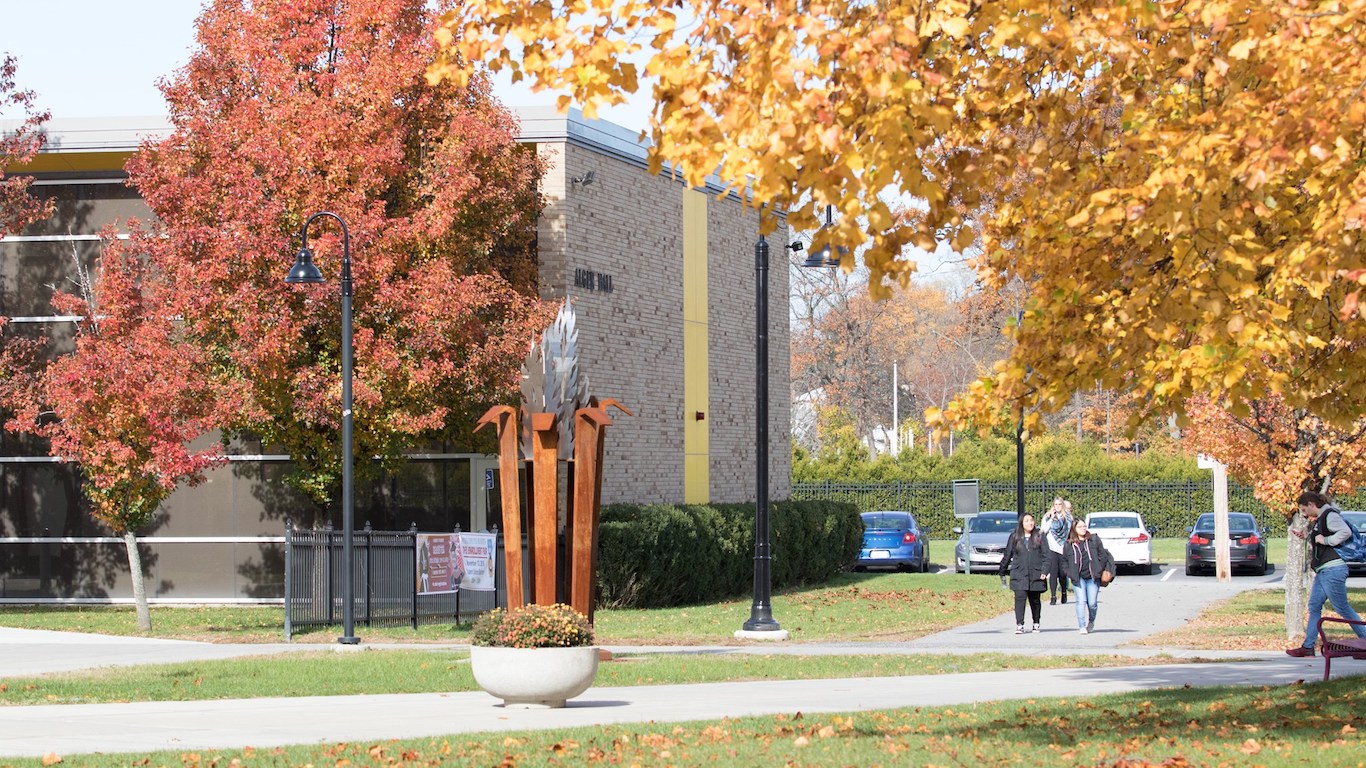
13. Rhode Island
> Premature death rate (per 100,000): 6,602 (13th lowest)
> Adult obesity rate: 27.7% (11th lowest)
> Adult smoking rate: 14.6% (15th lowest)
> Median household income: $64,340 (17th highest)
Some 89.1% of adults in Rhode Island have at least a high school diploma, slightly above the 88.3% national high school attainment rate. Educational attainment is one of the strongest predictors of health outcomes. Nationwide, the share of adults with a diploma who say they are in optimal health is 27.6 percentage points higher than adults without a diploma. In Rhode Island, the difference is 31.5 percentage points.
The state has the highest immunization rates for various diseases, including human papillomavirus, the most common sexually transmitted infection; meningitis; and diphtheria, tetanus, and whooping cough (the Tdap vaccine). Most people in Rhode Island have health insurance, which may improve health outcomes as it allows for easier access to health care. Only 4.4% of the population lacks health insurance — the fifth lowest percentage in the country and half the national figure.
See all stories featuring: Rhode Island
12. California
> Premature death rate (per 100,000): 5,665 (the lowest)
> Adult obesity rate: 25.8% (5th lowest)
> Adult smoking rate: 11.2% (2nd lowest)
> Median household income: $75,277 (6th highest)
In California there are 5,665 premature deaths per 100,000 residents, the lowest rate in all of the United States. The cancer death rate in the Golden State is also among the lowest in the country — 168.9 per 100,000 people, compared to the national rate of 189.3 per 100,000 people annually.
Californians also tend to have healthy habits. For example, only 21.0% of adults report no physical activity, the 10th lowest figure nationwide, and only 11.2% of adults say they are regular smokers, the second lowest rate in the country.
See all stories featuring: California
[in-text-ad-2]
11. New York
> Premature death rate (per 100,000): 5,830 (3rd lowest)
> Adult obesity rate: 27.6% (9th lowest)
> Adult smoking rate: 12.8% (6th lowest)
> Median household income: $67,844 (14th highest)
New York has the third highest number of doctors per capita, which is one factor that helps it rank among the healthiest states. There are 230.7 primary care physicians per 100,000 people in the Empire State, compared to a rate of 159.6 doctors nationwide. According to the United Health Foundation, a large number of general practitioners in an area may lead to better health outcomes and reductions in health disparities across population subgroups.
New York ranks among the healthiest states also because of the amount of money it spends on public health. New York spends an average of $148 per person on public health annually, the fifth most of any state.
See all stories featuring: New York
10. Colorado
> Premature death rate (per 100,000): 6,288 (8th lowest)
> Adult obesity rate: 22.9% (the lowest)
> Adult smoking rate: 14.5% (14th lowest)
> Median household income: $71,953 (11th highest)
Like many of the healthiest states, Colorado residents are among the wealthiest in the nation. A typical household income is almost $72,000 a year, more than in all but 10 states. In addition to higher incomes, more than 83% of Colorado residents exercise on a regular basis, the highest percentage in the country. This high rate of physical activity likely contributes to the state’s low obesity rate. Just 22.9% of adult residents are obese, the lowest rate nationwide. The low obesity rate, in turn, likely helps keep down the prevalence of diabetes and cardiovascular disease in the state. There are an average of 207 cardiovascular deaths per 100,000 people in Colorado a year, the third lowest rate, and just 7.0% of the adult population has been diagnosed with diabetes, the smallest share nationwide.
See all stories featuring: Colorado
[in-text-ad]

9. Washington
> Premature death rate (per 100,000): 6,094 (5th lowest)
> Adult obesity rate: 28.7% (13th lowest)
> Adult smoking rate: 12.0% (3rd lowest)
> Median household income: $74,073 (9th highest)
People in Washington State tend to have healthy habits. Just 17.6% of adults say they do not exercise and only 12.0% report smoking on a regular basis, both of which are the third smallest such shares in the country.
Washington also has a relatively low preventable hospitalization rate, an indication of effective utilization of outpatient services and the overall quality of health care in the state. There are only 32.7 preventable hospitalizations per 1,000 Medicare enrollees, the fifth lowest rate in the country. Healthy lifestyle choices and access to quality health care may contribute to the state’s low rate of heart disease deaths. There are just 222.4 cardiovascular deaths per 100,000 people annually, the sixth lowest rate in the United States.
See all stories featuring: Washington

8. New Jersey
> Premature death rate (per 100,000): 6,329 (9th lowest)
> Adult obesity rate: 25.6% (3rd lowest)
> Adult smoking rate: 13.1% (7th lowest)
> Median household income: $81,740 (2nd highest)
New Jersey ranks among the healthiest states because of several behavioral factors, including low rates of excessive drinking, adult obesity, and smoking. Wealth, which allows for access to higher quality health care and other components of a healthy lifestyle, may also help explain the state’s high ranking. Just 9.5% of New Jersey residents live below the poverty line, the fifth lowest poverty rate of any state and well below the 13.1% national figure. The Garden State also has the second highest median household income — close to $82,000 a year, or about $20,000 more than the U.S. median.
See all stories featuring: New Jersey

7. Minnesota
> Premature death rate (per 100,000): 5,683 (2nd lowest)
> Adult obesity rate: 30.1% (21st lowest)
> Adult smoking rate: 15.1% (18th lowest)
> Median household income: $70,315 (13th highest)
Minnesota has the lowest rate of cardiovascular deaths in the nation, at just 193.8 per 100,000 people. In all, 5,683 years of life were lost to premature death — before the age of 75 — for every 100,000 people in Minnesota in 2017, the second lowest rate in the United States. By contrast, almost 7,500 years of life were lost for every 100,000 Americans nationwide. The state’s high-quality clinical care likely contributes to favorable health outcomes. Only 10 states have fewer preventable hospitalizations relative to the number of Medicare beneficiaries, and only 4.4% of residents lack health insurance, half the national average. Drinking is one of the few metrics in which the state fared poorly — 21.8% of the state’s adult population drinks excessively, the seventh largest share in the nation.
See all stories featuring: Minnesota
[in-text-ad-2]

6. New Hampshire
> Premature death rate (per 100,000): 6,770 (17th lowest)
> Adult obesity rate: 29.6% (18th lowest)
> Adult smoking rate: 15.6% (22nd lowest)
> Median household income: $74,991 (7th highest)
New Hampshire has an infant mortality rate of just 3.9 deaths per 1,000 live births, the second lowest of any state. There are 226 cardiovascular deaths per 100,000 people in the state, the eighth lowest rate. Additionally, nearly all teenagers in the state — 97.5% — are vaccinated for tetanus, diphtheria, and whooping cough, the highest teenage Tdap immunization rate in the country. Infectious diseases such as chlamydia, whooping cough, and salmonella are less prevalent in New Hampshire than all but one state, West Virginia.
Residents also enjoy the state’s clean air. At 4.4 micrograms of harmful fine particulate matter per cubic meter, New Hampshire has the lowest air pollution rate in the country. Dirty air has been linked to stroke, lung cancer and heart disease.
See all stories featuring: New Hampshire
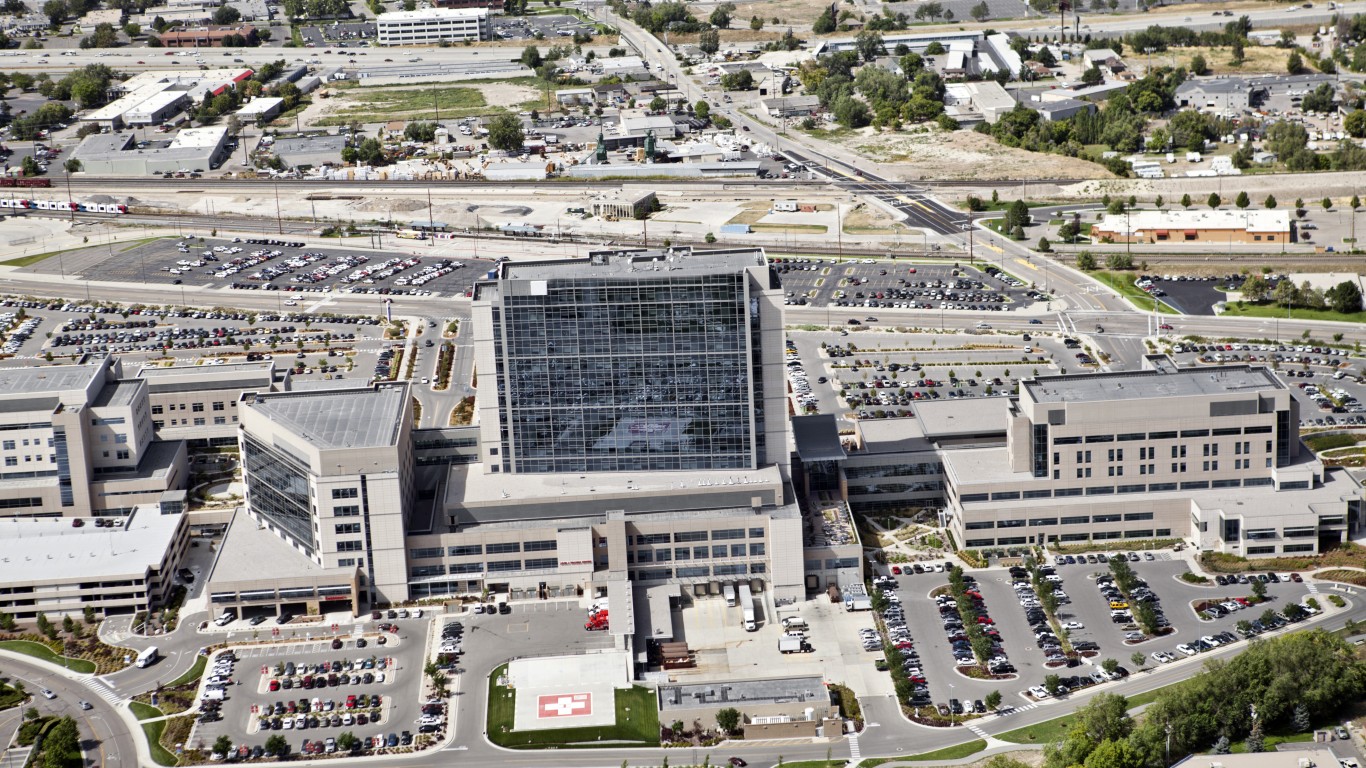
5. Utah
> Premature death rate (per 100,000): 6,391 (10th lowest)
> Adult obesity rate: 27.7% (11th lowest)
> Adult smoking rate: 9.0% (the lowest)
> Median household income: $71,414 (12th highest)
While high levels of excessive drinking are a weakness in most of the nation’s healthiest states, just 11.3% of Utah adults report excessive drinking — the lowest rate. In addition, just 9.0% of Utah residents are smokers, also the lowest rate in the country. And only 17.5% of state residents do not exercise regularly, the second lowest figure nationwide.
With a median household income of $71,414, Utah residents are among the nation’s wealthiest. High incomes help Utah households afford healthier food, medicine, and medical care. As in the majority of healthy states, Utah residents were also in relatively good physical health. The state has the nation’s lowest concentration of deaths from cancer as well as the second lowest rate of adults with diabetes.
See all stories featuring: Utah
[in-text-ad]

4. Connecticut
> Premature death rate (per 100,000): 6,091 (4th lowest)
> Adult obesity rate: 27.4% (7th lowest)
> Adult smoking rate: 12.2% (4th lowest)
> Median household income: $76,348 (5th highest)
Connecticut has one of the nation’s lowest smoking rates, at just 12.2% of the adult population. The state also has one of the lowest obesity rates in the United States, at 27.4% of the adult population.
The state fares well in health determinants related to both policy and clinical care. The child immunization rate of 75.3% is the tenth highest in the country, and the adolescent immunization rate of 95.4% is the third highest in the nation. Further, Connecticut had the fourth highest concentrations of primary care doctors at 220 per 100,000 people.
See all stories featuring: Connecticut

3. Hawaii
> Premature death rate (per 100,000): 6,245 (7th lowest)
> Adult obesity rate: 24.9% (2nd lowest)
> Adult smoking rate: 13.4% (9th lowest)
> Median household income: $80,212 (3rd highest)
A major reason for Hawaii’s high ranking among the healthiest states is its dedication to promoting good health through policy. The state provides $192 in public health funding per person, behind only Alaska and New Mexico. Just 4.0% of Hawaii’s population is not insured, the second-best rate nationwide. By comparison, 8.8% of Americans across the country are uninsured and, on average, states’ public health funding totals just $87 per person.
Beyond just policy, Hawaiians are among the least likely Americans to be obese or physically inactive. Preventable hospitalizations are the lowest in the nation at just 23.3 per 1,000 Medicare beneficiaries, compared to 49.4 per 1,000 beneficiaries nationwide. The state had just 209.8 cardiovascular deaths and 159.1 cancer deaths per 100,000 people, both among the lowest rates.
See all stories featuring: Hawaii
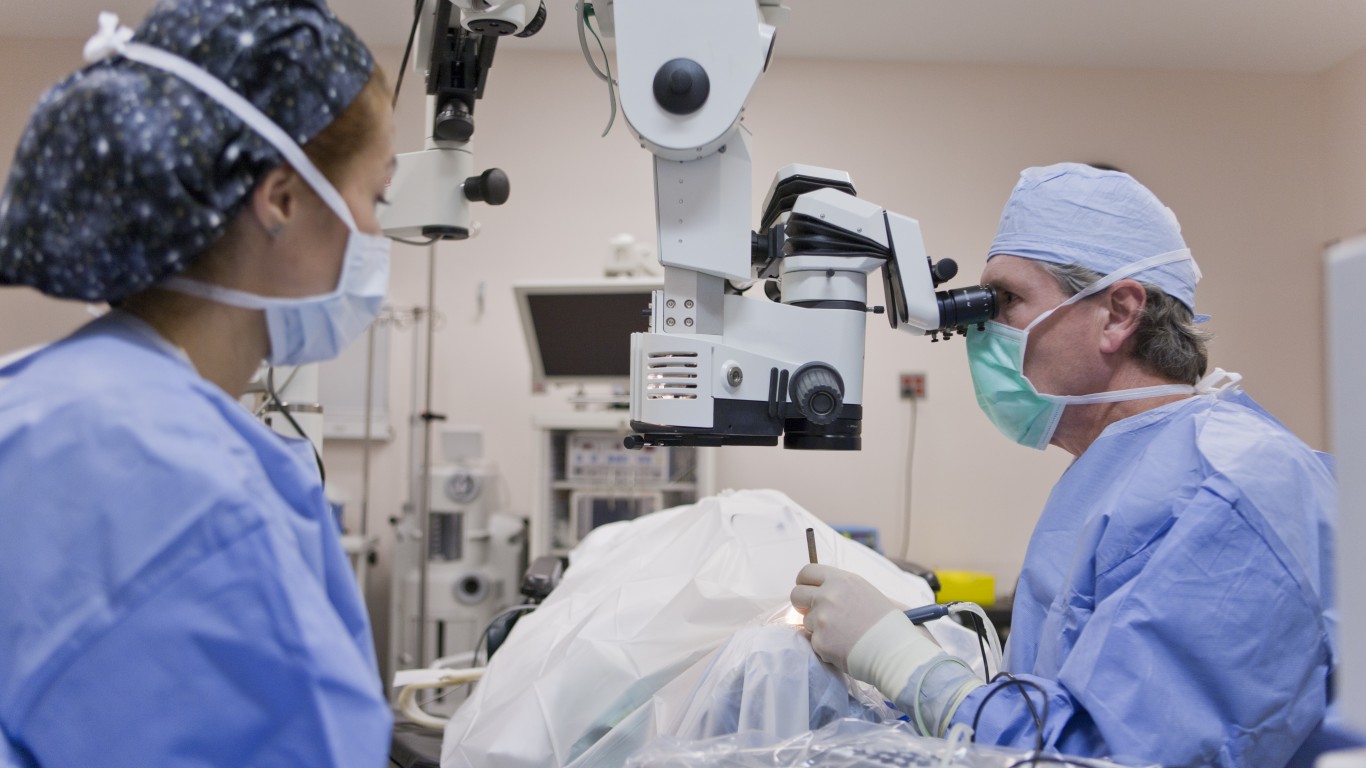
2. Massachusetts
> Premature death rate (per 100,000): 6,130 (6th lowest)
> Adult obesity rate: 25.7% (4th lowest)
> Adult smoking rate: 13.4% (9th lowest)
> Median household income: $79,835 (4th highest)
Massachusetts has the lowest rate of people without health care coverage in the nation, at just 2.8% of the population. By comparison, 8.8% of all Americans lack health insurance. In addition to having a largely insured population, Massachusetts also had the second highest concentration of primary care physicians in the U.S., at more than 247 for every 100,000 residents, as well as the highest concentration of dentists, at 82.7 per 100,000 people.
Low rates of smoking and obesity also help residents stay healthy. And high levels of immunization, too, help promote good health. About 82.1% of children between 19 months and 35 months have received the recommended doses of key vaccines. Immunization coverage among adolescents is the fifth highest, at 94.7%.
See all stories featuring: Massachusetts
[in-text-ad-2]

1. Vermont
> Premature death rate (per 100,000): 6,646 (14th lowest)
> Adult obesity rate: 27.5% (8th lowest)
> Adult smoking rate: 13.7% (10th lowest)
> Median household income: $60,782 (22nd highest)
Vermont is the healthiest state in the country. Obesity, smoking, and physical inactivity are relatively uncommon behaviors among Vermonters. Just over 90% report exercising on a regular basis, the fourth highest share in the country and just 27.5% of adults are obese. In comparison, 23.8% of Americans across the country say they don’t exercise and 30.9% are obese. The adult smoking rate is also significantly lower than the U.S. average at 13.7%, the 10th lowest, compared to 16.1% nationwide.
Vermont’s public health funding is among the highest in the nation. The state spends $144 per person for programs promoting nutrition, exercise, no smoking, and other healthy habits. In addition, the rate of uninsured residents is among the lowest in the country — 4.3%, more than half the national rate.
See all stories featuring: Vermont
Based on data provided by United Health Foundation’s America’s Health Rankings, 24/7 Tempo examined the 20 states with the highest overall scores. These scores were based on data covering each state population’s health behaviors, community and environment, public and health policies, clinical care, and health outcomes.
Behaviors such as smoking, community and environmental factors like the percentage of children living in poverty, state policies for health funding and immunization, and measure of clinical care quality such as the concentrations of dentists and doctors were all considered in the rank. Outcomes used in the scores included the annual number of deaths occuring before the age of 75 per 100,000 state residents (known as the premature death rate), cancer and cardiovascular disease deaths rates, infant mortality rates, and levels of physical and mental distress reported by state residents.
The percentage of each state’s population without health insurance and the median household income in each state came from the U.S. Census Bureau’s 2018 American Community Survey.
Credit Card Companies Are Doing Something Nuts
Credit card companies are at war. The biggest issuers are handing out free rewards and benefits to win the best customers.
It’s possible to find cards paying unlimited 1.5%, 2%, and even more today. That’s free money for qualified borrowers, and the type of thing that would be crazy to pass up. Those rewards can add up to thousands of dollars every year in free money, and include other benefits as well.
We’ve assembled some of the best credit cards for users today. Don’t miss these offers because they won’t be this good forever.
Flywheel Publishing has partnered with CardRatings for our coverage of credit card products. Flywheel Publishing and CardRatings may receive a commission from card issuers.
Thank you for reading! Have some feedback for us?
Contact the 24/7 Wall St. editorial team.
 24/7 Wall St.
24/7 Wall St.

